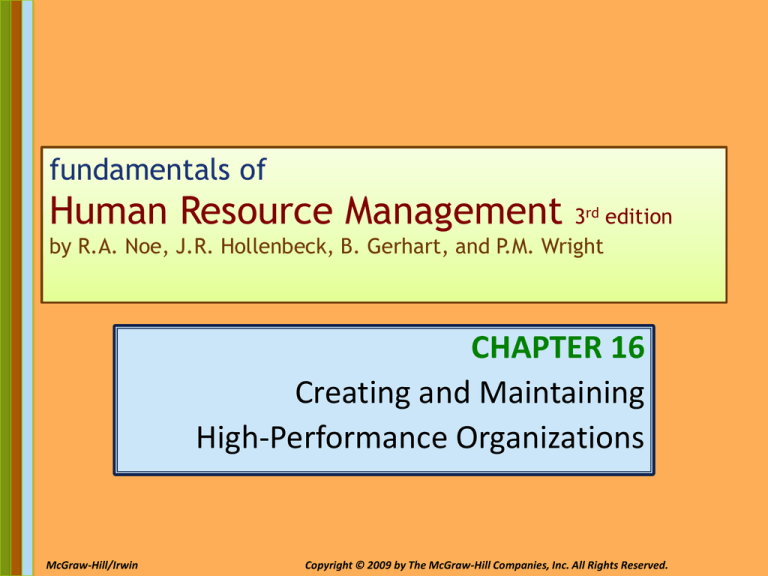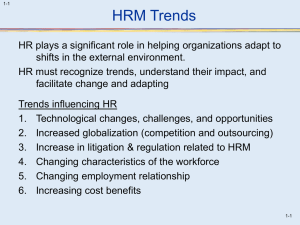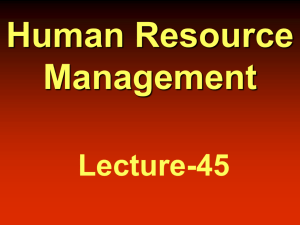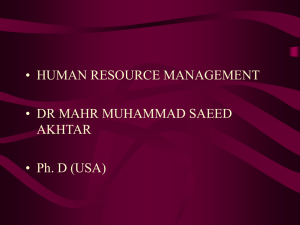
fundamentals of
Human Resource Management 3
rd
edition
by R.A. Noe, J.R. Hollenbeck, B. Gerhart, and P.M. Wright
CHAPTER 16
Creating and Maintaining
High-Performance Organizations
McGraw-Hill/Irwin
Copyright © 2009 by The McGraw-Hill Companies, Inc. All Rights Reserved.
16-1
What Do I Need to Know?
1. Define high-performance work systems and
identify the elements of such a system.
2. Summarize the outcomes of a highperformance work system.
3. Describe the conditions that create a highperformance work system.
4. Explain how human resource management can
contribute to high performance.
16-2
What Do I Need to Know? (continued)
5. Discuss the role of HRM technology in highperformance work systems.
6. Summarize ways to measure the effectiveness
of human resource management.
16-3
High-Performance Work Systems
• High-performance work system – the right
combination of people, technology, and
organizational structure that makes full use of
the organization’s resources and opportunities
in achieving its goals.
• To function as a high-performance work
system, each of these elements must fit well
with the others in a smoothly functioning
whole.
16-4
Figure 16.1:
Elements of a High-Performance Work
System
16-5
Elements of a High-Performance
Work System
• Organizational structure: the way the organization
groups its people into useful divisions,
departments, and reporting relationships.
• Task design: determines how the details of the
organization’s necessary activities will be grouped,
whether into jobs or team responsibilities.
• People: well suited and well prepared for their jobs.
16-6
Elements of a High-Performance
Work System (continued)
• Reward systems: contribute to high
performance by encouraging people to strive
for objectives that support the organization’s
overall goals.
• Information systems: modern information
systems have enabled organizations to share
information widely.
16-7
In a high-performance work system, all
the elements – people, technology, and
organizational structure – work together
for success.
16-8
Outcomes of a High-Performance
Work System
• Outcomes of a high-performance work system
include higher productivity and efficiency.
• These outcomes contribute to higher profits.
• Other outcomes include:
– High product quality
– Great customer satisfaction
– Low employee turnover
16-9
Figure 16.2:
Outcomes of a High-Performance Work
System
16-10
Outcomes of a High-Performance
Work System (continued)
• The outcomes of each employee and work group
contribute to the system’s overall high
performance.
• The organization’s individuals and groups work
efficiently, provide high-quality goods and
services, etc., and in this way they contribute to
meeting the organization’s goals.
• When the organization adds or changes goals,
people are flexible and make changes to as
needed to meet the new goals.
16-11
Conditions that Contribute to
High Performance
• Teams perform work.
• Employees participate in selection.
• Employees receive formal performance
feedback and are actively involved in the
performance improvement process.
• Ongoing training is emphasized and rewarded.
• Employees’ rewards and compensation relate
to the company’s financial performance.
16-12
Conditions that Contribute to
High Performance (continued)
• Equipment and work processes are structured
and technology is used to encourage
maximum flexibility and interaction among
employees.
• Employees participate in planning changes in
equipment, layout, and work methods.
• Work design allows employees to use a variety
of skills.
16-13
Conditions that Contribute to
High Performance (continued)
• Employees understand how their jobs
contribute to the finished product or service.
• Ethical behavior is encouraged.
16-14
Learning Organizations
• Learning organization – an organization that
supports lifelong learning by enabling all
employees to acquire and share knowledge.
• The people in a learning organization have
resources for training, and they are encouraged
to share their knowledge with colleagues.
• Managers take an active role in identifying
training needs and encouraging the sharing of
ideas.
16-15
Key Features of Learning Organizations
1. Continuous learning – each employee’s and each
group’s ongoing efforts to gather information and
apply the information to their decisions.
2. Knowledge is shared – one challenge is to shift the
focus of training away from teaching skills and
toward a broader focus on generating and sharing
knowledge.
3. Critical, systemic thinking – is widespread and
occurs when employees are encouraged to see
relationships among ideas and think in new ways.
16-16
Key Features of Learning Organizations
(continued)
4. Learning culture – a culture in which learning is
rewarded, promoted, and supported by managers
and organizational objectives.
5. Employees are valued – the organization recognizes
that employees are the source of its knowledge. It
therefore focuses on ensuring the development and
well-being of each employee.
16-17
Job Satisfaction
16-18
Test Your Knowledge
• Charlotte is a manager overseeing the work of
a team. Which of the following behaviors
would empower the team the least?
a) Opening lines of communication between the
team and other groups within the organization.
b) Directing the team and monitoring their day-today activities.
c) Ensure the team has the resources they need.
d) Keep the team informed as new, relevant
information becomes available.
16-19
Research has found that teachers’ job
satisfaction is associated with high
performance of the schools where they
teach.
16-20
Test Your Knowledge
• Kamran has worked for the same company for 3
years, is enthusiastic and passionate about his
work, hasn’t missed a day in two years, and has
several close friends he enjoys working with.
Which of the following best describes Kamran?
a)
b)
c)
d)
He is satisfied with his job.
He is empowered.
He is experiencing occupational intimacy.
He is probably going to quit soon.
16-21
Table 16.1: HRM’s Contribution to High
Performance
• HRM practices match
organization’s goals
• Individuals and groups
share knowledge
• Work is performed by
teams
• Organization
encourages continuous
learning
• Work design permits
flexibility in where and
when tasks are
performed
• Selection system is job
related and legal
• Performance
management system
measures customer
satisfaction and quality
16-22
Table 16.1: HRM’s Contribution to High
Performance (continued)
• Organization monitors
employees’ satisfaction
• Discipline system is
progressive
• Pay system rewards
skills and
accomplishments
• Skills and values of a
diverse workforce are
valued and used
• Technology reduces
time and costs of tasks
while preserving quality
16-23
• To develop future leaders, new IBM managers
participate in IBM’s Basic Blue program for an
intensive nine-month training program.
• IBM is considered one of the best companies in
the development of future leaders.
16-24
Performance Management
• Each aspect of performance management should be
related to the organization’s goals.
• Business goals should influence the:
– kinds of employees selected and their training
– requirements of each job
– measures used for evaluating results
• This means the organization:
– identifies what each department must do to achieve the
desired results
– defines how individual employees should contribute to
their department’s goals
16-25
Figure 16.3: Employee Performance as a
Process
16-26
Performance Management (continued)
Guidelines to make the performance management
system support organizational goals:
1. Define and measure performance in precise terms.
2. Link performance measures to meeting customer
needs.
3. Measure and correct for the effect of situational
constraints.
16-27
HRM Technology
• New technologies – applications of knowledge,
procedures, and equipment that have not
previously been used.
– Transaction Processing: Computations and
calculations used to review and document HRM
decisions and practices. These include
documenting employee relocation, payroll
expenses, and training course enrollments.
16-28
HRM Technology (continued)
– Decision Support Systems: These are systems
designed to help managers solve problems. They
usually include a "what if" feature.
– Expert Systems: Are computer systems
incorporating the decision rules of people deemed
to have expertise in a certain area.
– Relational Databases: Store data in separate files
that can be linked by common elements.
16-29
Human Resource Management Online:
E-HRM
• Improving HRM effectiveness through online
technology.
• The speed requirements of business force
HRM managers to explore how to leverage
technology for the delivery of HRM activities.
• With Internet technology, organizations can
use E-HRM to let all the organzation’s
employees help themselves to the HR
information they need whenever they need it.
16-30
Online Recruiting Offers Many Benefits
16-31
Measuring the Effectiveness of
Human Resource Management
Customer-oriented approach to
HRM
Human resource management audit
Analyzing the effect of HRM
programs
16-32
Customer-Oriented Perspective of
Human Resource Management
Who Are Our
Customers?
• Line managers
• Strategic
planners
• Employees
What Do Our
Customers Need?
How Do We Meet
Customer Needs?
• Committed
employees
• Competent
employees
• Qualified
staffing
• Performance
Management
• Rewards
• Training and
Development
16-33
Human Resource Management Audits
• HRM audit – a formal review of the outcomes
of HRM functions, based on identifying key
HRM functions and measures of business
performance.
• The audit may also look at any other measure
associated with successful management of
human resources.
– e.g., legal compliance, safety, labor relations
16-34
Table 16.3: Key
Measures of
Success for an
HRM Audit
16-35
Analyzing the Effect of HRM Programs
• This analysis can measure a program’s success
in terms of whether it:
– achieved its objectives
– delivered value in an economic sense
• The analysis can measure the dollar value of
the program’s costs and benefits.
• Successful programs should deliver value that
is greater than the program’s costs.
16-36
Analyzing the Effect of HRM Programs
(continued)
• HR departments should be able to improve their
performance through some combination of
greater efficiency and greater effectiveness.
• Greater efficiency – means the HR department
uses fewer and less-costly resources to perform
its functions.
• Greater effectiveness – means that what the HR
department does has a more beneficial effect on
employees and the organization’s performance.
16-37
Test Your Knowledge
• The HR director of a medium-sized corporation
spends 90% of his time meeting and working with
fellow HR staff. He is primarily concerned with
ensuring the company meets all legal requirements
with regard to HR activities. This HR director:
a)
b)
c)
d)
Is a major contributor to a high-performance organization
Has a strategic focus
Is concerned with customer satisfaction
Has limited the utility and value he could bring to the
organization
16-38
Summary
• A high-performance work system is the right
combination of people, technology, and
organizational structure that makes full use of the
organization’s resources and opportunities in
achieving its goals.
• A high-performance work system achieves the
organization’s goals, typically including growth,
productivity, and high profits.
16-39
Summary (continued)
• Many conditions contribute to high-performance
work systems by giving employees skills, incentives,
knowledge, autonomy, and employee satisfaction.
• Organizations can improve performance by creating a
learning organization, in which people constantly
learn and share knowledge so that they continually
expand their capacity to achieve the results they
desire.
16-40
Summary (continued)
• By taking a customer-oriented approach, HRM can
improve quality by defining the internal customers
who use its services and determining whether it is
meeting those customers’ needs.
• One way to do this is with an HRM audit.
• Another way to measure HRM effectiveness is to
analyze specific programs or activities.
• This analysis can measure success in terms of
whether a program met its objectives and whether it
delivered value in an economic sense.
16-41









